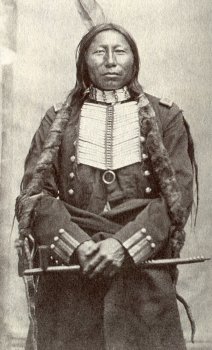Crow King facts for kids
Crow King (whose name in the Lakota language was Kȟaŋǧí Yátapi) was an important leader of the Hunkpapa Sioux people. He was also known by other names like Medicine Bag That Burns or simply Medicine Bag. Crow King was a respected war chief, which means he was a leader in battles for his tribe. He lived during a time when Native American tribes were fighting to protect their lands and way of life.
Crow King and the Battle of Little Bighorn
Crow King is best known for his role in the Battle of Little Bighorn. This famous battle happened in 1876. It was a major fight between several Native American tribes, including the Lakota and Cheyenne, and the United States Army.
During the battle, Crow King was one of the main war chiefs working with Sitting Bull, another very famous Lakota leader. Crow King led about eighty warriors in the fight. They attacked the soldiers led by General Custer from the south. This attack helped other Native American leaders, like Crazy Horse and Chief Gall, to surround the 7th Cavalry soldiers. Crow King's actions were a key part of the Native American victory in this battle.
Later Life and Family
Crow King passed away on April 5, 1884. Reports from that time say he died from a long illness, possibly a severe cold. He was also said to have received Catholic religious rites before his death. The exact place where he was buried is not known.
Crow King had two daughters who became orphans after his death. Their names were Mary Laura Crow King, also known as "Weasel," and Emma Crow King, also known as "Red Deer Kid." Mary Laura was born in 1876, and Emma was born in 1880. Emma later married a man named Paul Cournoyer. She and her two children moved to Armour, South Dakota.
See also


